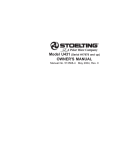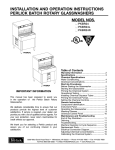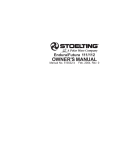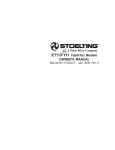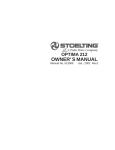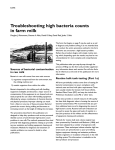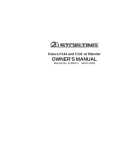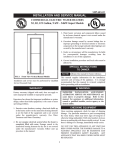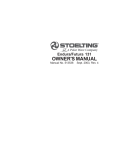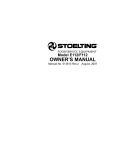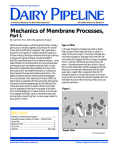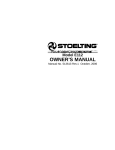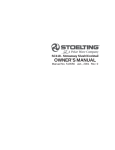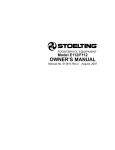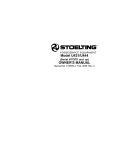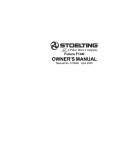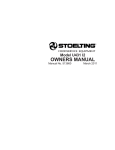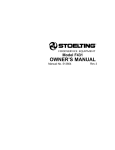Download Stoelting O111 User's Manual
Transcript
O111 IntelliTec Models OWNER’S MANUAL Manual No. 513588-1 Sept. 2006 Owner's Manual For O111 Stoelting Counter Model Gravity Freezer Shake and Frozen Beverage This manual provides basic information about the freezer. Instructions and suggestions are given covering its operation and care. The illustrations and specifications are not binding in detail. We reserve the right to make changes to the freezer without notice, and without incurring any obligation to modify or provide new parts for freezers built prior to date of change. DO NOT ATTEMPT to operate the freezer until instructions and safety precautions in this manual are read completely and are thoroughly understood. If problems develop or questions arise in connection with installation, operation, or servicing of the freezer, contact the company at the following location: STOELTING, LLC 502 Hwy. 67 Kiel, WI 53042 Ph: 800-558-5807 Fax: 920-894-7029 A Few Words About Safety Safety Information Read and understand the entire manual before operating or maintaining Stoelting equipment. This Owner's Manual provides the operator with information for the safe operation and maintenance of Stoelting equipment. As with any machine, there are hazards associated with their operation. For this reason safety is emphasized throughout the manual. To highlight specific safety information, the following safety definitions are provided to assist the reader. The purpose of safety symbols is to attract your attention to possible dangers. The safety symbols, and their explanations, deserve your careful attention and understanding. The safety warnings do not by themselves eliminate any danger. The instructions or warnings they give are not substitutes for proper accident prevention measures. If you need to replace a part, use genuine Stoelting parts with the correct part number or an equivalent part. We strongly recommend that you do not use replacement parts of inferior quality. Safety Alert Symbol: This symbol Indicates danger, warning or caution. Attention is required in order to avoid serious personal injury. The message that follows the symbol contains important information about safety. Signal Word: Signal words are distinctive words used throughout this manual that alert the reader to the existence and relative degree of a hazard. WARNING The signal word “WARNING” indicates a potentially hazardous situation, which, if not avoided, may result in death or serious injury and equipment/property damage. CAUTION The signal word “CAUTION” indicates a potentially hazardous situation, which, if not avoided, may result in minor or moderate injury and equipment/property damage. CAUTION The signal word “CAUTION” not preceded by the safety alert symbol indicates a potentially hazardous situation, which, if not avoided, may result in equipment/ property damage. NOTICE The signal word “NOTICE” indicates information or procedures that relate directly or indirectly to the safety or personnel or equipment/property. TABLE OF CONTENTS SECTION DESCRIPTION PAGE 1. INTRODUCTION 1.1 Description ............................................................................................................. 1.2 Specifications ........................................................................................................ 1 1 2. INSTALLATION INSTRUCTIONS 2.1 Safety Precautions ................................................................................................. 2.2 Shipment and Transit.............................................................................................. 2.3 Freezer Installation ................................................................................................. 3 4 4 3. INITIAL SET-UP AND OPERATION 3.1 Operator's Safety Precautions ................................................................................ 3.2 Operating Controls and Indicators........................................................................... 3.3 Sanitizing ............................................................................................................... 3.4 Freeze Down and Operation ................................................................................... 3.5 Mix Information ....................................................................................................... 3.6 Removing Mix From Freezer .................................................................................. 3.7 Cleaning The Freezer ............................................................................................. 3.8 Disassembly of Freezer Parts ................................................................................ 3.9 Cleaning The Freezer Parts .................................................................................... 3.10 Sanitize Freezer and Freezer Parts ....................................................................... 3.11 Assembly of Freezer ............................................................................................. 3.12 Routine Cleaning ................................................................................................... 3.13 Preventive Maintenance ........................................................................................ 3.14 Extended Storage ................................................................................................. 3.15 Product Consistency Adjustment ........................................................................... 3.16 Locking Out Control Panel ..................................................................................... 5 5 7 8 9 9 9 9 10 11 11 12 12 14 15 15 4. TROUBLESHOOTING CHARTS 4.1 Error Codes ............................................................................................................ 4.2 Troubleshooting Error Codes .................................................................................. 4.3 Troubleshooting Charts ........................................................................................... 17 17 19 5. REPLACEMENT PARTS ........................................................................................... 21 LIST OF ILLUSTRATIONS FIGURE TITLE PAGE 1-1 Model O111 Freezer .............................................................................................. 1 1-2 Freezer Specifications ........................................................................................... 1 2-1 Warning Label Locations ....................................................................................... 3 2-2 Space and Ventilation Requirements ..................................................................... 4 2-3 Electrical Plug ....................................................................................................... 4 3-1 Freezer Controls .................................................................................................... 5 3-2 IntelliTec Control .................................................................................................... 7 3-3 Mix Inlet Regulator ................................................................................................. 7 3-4 Sanitizing Hopper .................................................................................................. 8 3-5 During Freezing Cycle ........................................................................................... 8 3-6 Auger Flight Wear ..................................................................................................10 3-7 Removing Auger Support .......................................................................................10 3-8 Removing Auger Shaft and Flights ......................................................................... 10 3-9 Removing O-Ring ...................................................................................................10 3-10 Cleaning Freezer Barrel .........................................................................................11 3-11 Auger Springs ........................................................................................................11 3-12 Front Door Parts .................................................................................................... 12 3-13 Product Consistency Control .................................................................................15 3-14 Locked Control Display (In Serve Mode) .................................................................15 SECTION 1 DESCRIPTION AND SPECIFICATIONS 1.1 DESCRIPTION The Stoelting Optima 111 counter freezer is gravity fed. The freezer is equipped with fully automatic controls to provide a uniform product. The freezer is designed to operate with almost any type of commercial soft serve or non-dairy mix available, including ice milk, ice cream, yogurt, and frozen dietary desserts. This manual is designed to assist qualified service personnel and operators in the installation, operation and maintenance of the Stoelting O111 gravity freezer. Figure 1-1 Model O111 Freezer Figure 1-2 Freezer Specifications 1 MODEL OPTIMA 111 COUNTER MODEL GRAVITY FREEZER DIMENSIONS: Freezer: 19" (50.2 cm) wide x 31.5" (80 cm) deep x 37.5" (95.2 cm) high Crated: 28.75" (73 cm) wide x 38.75" (98.4 cm) deep x 43" (109.2 cm) high WEIGHT: Freezer: 310 lbs (140.5 kg) Crated: 380 lbs. (172.4 kg) ELECTRICAL: Description Optima 111 Voltage AC 1 PH 208/230V Total Run Amps 13.00 Drive Motor 1.5 HP Use 20 amp HACR circuit breaker. Automatic safeguard circuit built into electronic control-protects major freezer components under abnormal operating conditions. COOLING: Air cooled requires minimum 3" (7.6 cm) air clearance on right and left hand side. No clearance needed in the rear. Water cooled required 3/8" I.D. water supply line and 3/8" I.D. drain line minimum. HOPPER: 6.5 Gallons (24.6 liters) refrigerated and insulated. 2 SECTION 2 INSTALLATION INSTRUCTIONS 2.1 SAFETY PRECAUTIONS If danger, warning or caution labels are needed, indicate the part number, type of label, location of label, and quantity required along with your address and mail to: Do not attempt to operate the freezer until the safety precautions and operating instructions in this manual are read completely and are thoroughly understood. STOELTING, INC. ATTENTION: Customer Service 502 Hwy. 67 Kiel, Wisconsin 53042 Take notice of all warning labels on the freezer. The labels have been put there to help maintain a safe working environment. The labels have been designed to withstand washing and cleaning. All labels must remain legible for the life of the freezer. Labels should be checked periodically to be sure they can be recognized as warning labels. Figure 2-1 Warning Label Locations 3 2.2 SHIPMENT AND TRANSIT D. Place the OFF-ON switch in the OFF position. The freezer has been assembled, operated and inspected at the factory. Upon arrival at the final destination, the complete freezer must be checked for any damage which may have occurred during transit. E. Connect the power cord to the proper power supply. The plug is designed for 208 or 230 volt/20 amp duty. Check the nameplate on your freezer for proper supply. The unit must be connected to a properly grounded receptacle. The electrical cord furnished as part of the freezer has a three prong grounding type plug (Fig. 2-3). The use of an extension cord is not recommended, if necessary use one with a size 12 gauge or heavier with ground wire. Do not use an adapter to get around grounding requirement. With the method of packaging used, the freezer should arrive in excellent condition. THE CARRIER IS RESPONSIBLE FOR ALL DAMAGE IN TRANSIT, WHETHER VISIBLE OR CONCEALED. Do not pay the freight bill until the freezer has been checked for damage. Have the carrier note any visible damage on the freight bill. If concealed damage and/or shortage is found later, advise the carrier within 10 days and request inspection. The customer must place claim for damages and/or shortages in shipment with the carrier. Stoelting, Inc. cannot make any claims against the carrier. 2.3 FREEZER INSTALLATION 115V 20 Amp Installation of the freezer involves moving the freezer close to its permanent location, removing all crating, setting in place, assembling parts, and cleaning. A. Uncrate the freezer. B. Accurate leveling is necessary for correct drainage of freezer barrel and to insure correct overrun. Place a bubble level on top of the freezer at each corner to check for level condition. If adjustment is necessary, level the freezer by turning the bottom part of each leg in or out. Then separate freezer base gasket and install with seam to the back and angle to the top. C. 208/230V 20 Amp Figure 2-3 Electrical Plug WARNING Do not alter or deform electrical plug in any way. Altering the plug to fit into an outlet of different configuration may cause fire, risk of electrical shock, product damage and will void warranty. If the freezer is equipped with an air cooled condenser, correct ventilation is required. The right side of the freezer is the air intake and left side discharge. Both sides must have 3" clearance the top requires 10" of clearance. F. CAUTION Failure to provide adequate ventilation will void warranty. Figure 2-2 Space and Ventilation Requirements 4 Install the drip tray, drain tray, hopper cover and other miscellaneous parts on the freezer. SECTION 3 INITIAL SETUP AND OPERATION G. 3.1 OPERATOR’S SAFETY PRECAUTIONS SAFE OPERATION IS NO ACCIDENT; observe these rules: Do not operate under unsafe operating conditions. Never operate the freezer if unusual or excessive noise or vibration occurs. A. Know the freezer. Read and understand the Operating Instructions. B. Notice all warning labels on the freezer. C. Wear proper clothing. Avoid loose fitting garments, and remove watches, rings or jewelry which could cause a serious accident. D. Maintain a clean work area. Avoid accidents by cleaning up the area and keeping it clean. WARNING E. Stay alert at all times. Know which switch, push button or control you are about to use and what effect it is going to have. F. Disconnect electrical cord for maintenance. Never attempt to repair or perform maintenance on the freezer until the main electrical power has been disconnected. High voltage will shock, burn or cause death. The OFF-ON switch must be placed in the OFF position prior to disassembling for cleaning or servicing. Do not operate machine with cabinet panels removed. 3.2 OPERATING CONTROLS AND INDICATORS Before operating the freezer, it is required that the operator know the function of each operating control. Refer to Figure 3-1 for the location of the operating controls on the freezer. Dispense Rate Adjustor Main Power OFF-ON IntelliTec Control (See Figure 3-2) Figure 3-1 Freezer Controls 5 A. Spigot Switch The MIX LOW message will appear on the LCD display to alert the operator to a low mix condition. The message will display when there is approximately one gallon of mix left in the hopper. When the MIX LOW message is displayed, refill hopper immediately. The spigot switch will automatically actuate the auger drive and refrigeration systems when the spigot is opened to dispense product. When the spigot is closed, the drive motor and compressor will remain “on” until the product in the barrel reaches the proper consistency. B. NOTE Main Freezer Power OFF-ON Switch Failure to refill hopper immediately may result in operational problems. The Main Freezer Power OFF-ON switch is a two position toggle switch used to supply power to the control circuit. When the switch is in the OFF position, power will not be supplied to the control board or refrigeration system. When the switch is in the ON position, the freezer will operate in the freezing mode or cleaning mode. The freezer will be in the sleep mode until a switch is activated. C. G. The dispense rate adjuster limits the opening of the spigot. To adjust product dispense rate, turn the adjusting knob clockwise for slower flow and counterclockwise for faster flow. It takes at least five complete turns of the adjusting knob to make a noticeable difference in the dispense rate. PUSH TO FREEZE Button H. The PUSH TO FREEZE button is used to initiate the serve mode. To start the freezer, place the Main Freezer Power OFF-ON switch in the ON position and press the PUSH TO FREEZE button. I. After the drive motor starts, there is a 3 second delay before the compressor starts. LEDs The membrane switch features two lights; a green LED and an amber LED. The green LED is lit during serve mode. During freeze down, the green LED is not lit. When product consistency approaches 75% in the freezing cylinder, the green LED flashes. The amber LED is lit during all other modes. In the event of an error or when the freezing cylinder is off, both LEDs will alternatively flash. NOTE If the freezer shuts off, and alternating green and amber lights are flashing, the freezer is in an error condition. If the LCD displays an error, turn the Main Freezer Power OFF-ON switch to the OFF position, correct the problem (Refer to Troubleshooting in Section 4) and turn the freezer back on. E. CLEAN Button The CLEAN button will stop all refrigeration and start auger rotation. A CLEAN message will display on the LCD screen and a 5 minute timer begins. To exit the CLEAN mode, press the CLEAN button again. If the freezer is left in CLEAN for more than 20 minutes, it will go into an error to prevent damage to the freezing cylinder. When this error occurs, refrigeration will start to prevent mix spoilage. To reset, place the Main Freezer Power OFF-ON switch in the OFF position and back in the ON position. F. FRONT DOOR SAFETY SWITCH The front door safety switch prevents the auger from turning when the front door is removed. The switch is open when the door is not in place and closed when the door is properly installed. NOTE D. DISPENSE RATE ADJUSTERS Mix Low Light Indicator 6 MENU NAVIGATION BUTTONS Push to Freeze tions for applicable codes and recommended sanitizing products and procedures. The frequency of sanitizing must comply with local health regulations. Green Light Mix sanitizer according to manufacturer’s instructions to provide a 100 parts per million strength solution. Mix sanitizer in quantities of no less than 2 gallons (7.5 liters) of 90° to 110°F (32° to 43°C) water. Allow sanitizer to contact the surfaces to be sanitized for 5 minutes. Any sanitizer must be used only in accordance with the manufacturer’s instructions. Amber Light Clean Switch SEL Button SET Button Left Arrow Button CAUTION Up Arrow Button Do not allow sanitizer to remain in contact with stainless steel freezer parts for prolonged periods. Prolonged contact of sanitizer with freezer may cause corrosion of stainless steel parts. Figure 3-2 IntelliTec Control The Menu Navigation Buttons allow the user to display information regarding the freezer's status of operation as well as adjust product consistency. In general, sanitizing may be conducted as follows: Selection Button (SEL) The SEL button is not functional in the normal operation mode. This button is only used by service technicians for freezer calibration. Set Button (SET) Pressing this button will save a change made to the product consistency setting. Refer to Section 3-15 for consistency adjustment procedures. Left Arrow Button (Õ) Pressing any button on the control panel will automatically illuminate the display. The backlight will turn off several seconds after use. To keep the display constantly lit, press and hold the left (Õ) button for five seconds. The backlight function can be reset to normal operation in the same manner. A. Prepare Stera-Sheen Green Label Sanitizer or equivalent according to manufacturer’s instructions to provide a 100ppm strength solution. Mix the sanitizer in quantities of no less than 2 gallons of 90° to 110°F (32° to 43°C) water. Any sanitizer must be used only in accordance with the manufacturer’s instructions. B. Push the mix inlet regulator into hopper with air inlet (long) tube toward the front of the freezer (Fig. 3-3). C. Place the Main Freezer Power OFF-ON toggle switch in the ON position and press the CLEAN switch. Check for leaks. Up Arrow Button (×) Pressing this button will change the value of the product consistency. Refer to Section 3-15 for consistency adjustment procedures. 3.3 SANITIZING Sanitizing must be done after the freezer is cleaned and just before the hopper is filled with mix. Sanitizing the night before is not effective. However, you should always clean the freezer and parts after each use. THE UNITED STATES DEPARTMENT OF AGRICULTURE AND THE FOOD AND DRUG ADMINISTRATION REQUIRE THAT ALL CLEANING AND SANITIZING SOLUTIONS USED WITH FOOD PROCESSING EQUIPMENT BE CERTIFIED FOR THIS USE. Figure 3-3 Mix Inlet Regulator When sanitizing the freezer, refer to local sanitary regula- 7 E. The freezer barrel will automatically fill until it is about 1/2 full. If freezer barrel does not fill, check for obstruction in the mix inlet regulator. If freezer barrel fills over 1/2 full, indicated by low overrun, check for leaks at the mix inlet regulator o-ring or check if the mix inlet regulator was installed correctly or that the freezer is level. F. Place the Main Freezer Power OFF-ON switch in the ON position, then press the PUSH TO FREEZE switch. NOTE After the drive motor starts, there is a 3 second delay before the compressor starts. G. After about 6 to 10 minutes the product will be at consistency and the LCD screen will display "SERVE". The product is ready to serve. Freeze down time may be longer for some frozen diet dessert mixes. High ambient temperatures may extend freeze down time. H. For normal dispensing, pull the spigot handle down to fully open the spigot. Figure 3-4 Sanitizing Hopper D. E. Clean sides of hopper, mix inlet regulator and underside of hopper cover using a sanitized soft bristle brush dipped in the sanitizing solution. (Fig. 3-4). NOTE Refrigeration is automatically activated when the spigot is opened. Close the spigot completely after dispensing. After five minutes, place a bucket under the spigot and open spigot to drain sanitizing solution. When solution has drained, press the CLEAN button to stop the auger. Allow the freezer barrel to drain completely. I. 3.4 FREEZE DOWN AND OPERATION The freezer is designed to dispense the product at a reasonable draw rate. If the freezer is overdrawn, the result is a soft product or a product that will not dispense at all. If this should occur, wait until the bars fill the lower section of the display (Fig. 3-5). This section covers the recommended operating procedures to be followed for the safe operation of the freezer. A. Sanitize just prior to use. B. Place the Main Freezer Power OFF-ON switch in the OFF position. NOTE Make sure the mix inlet regulator is in place before adding mix. C. With spigot open, pour approximately 1 gallon (3.8 liters) of fully thawed mix into the hopper. Allow the mix to flush out about 8 ounces (0.23 liters) of sanitizing solution and liquid mix. Close the spigot. D. Fill hopper with approximately 3 gallons (11.4 liters) of pre-chilled (40°F or 4°C) mix. NOTE Do not overfill the hopper. Mix level must not be higher than the air inlet tube on the mix inlet regulator. Figure 3-5 During Freezing Cycle 8 J. Do not operate the freezer when the MIX LOW light is on or with less than 1-3/4 inches (4.4 cm) of mix in the hopper. Refill the hopper immediately. 3.7 CLEANING THE FREEZER NOTE The frequency of cleaning the freezer and freezer parts must comply with local health regulations. NOTE The freezer has standby and sleep modes. When the freezer is not used, after a preset number of freezing cycles, it will enter the standby mode (followed by sleep mode) and remain there until someone draws a product or presses the PUSH TO FREEZE button. In the sleep mode, the freezer will keep the product below 41°F (5°C). Sleep modes are not to be used in place of cleaning and sanitizing. Frequency of cleaning and sanitizing is determined by Federal, State, and local regulatory agencies. After the mix has been removed from the freezer, the freezer must be cleaned. To clean the freezer, refer to the following steps: A. Fill the hopper with 2 gallons (7.5 liters) of tap water. B. Place the Main Freezer Power OFF-ON switch in the ON position and press the CLEAN switch. The auger will start to rotate. C. Allow the water to agitate for approximately 30 seconds. NOTE 3.5 MIX INFORMATION If freezer is left in CLEAN for more than 20 minutes, the display will show an error code. To reset, place the Main Freezer Power OFF-ON switch in the OFF position and back in the ON position. Mix can vary considerably from one manufacturer to another. Differences in the amount of butterfat content and quantity and quality of other ingredients have a direct bearing on the finished frozen product. A change in freezer performance that cannot be explained by a technical problem may be related to the mix. Proper product serving temperature varies from one manufacturer’s mix to another. Soft serve mixes generally provide satisfactory product from 18° to 20°F (-7° to -6°C), shake mixes 24° to 28°F (-4° to -2°C). When checking the temperature, stir the thermometer in the frozen product to read the true temperature. Old mix or mix that has been stored at elevated temperatures will produce poor-quality product with a bad taste and unacceptable appearance. To retard bacteria growth in dairy based mixes, the best storage temperature range is between 36° to 40°F (2.2° to 4.4°C). Press the CLEAN button to rotate the auger. Allow the mix to agitate in freezer barrel until the mix has become a liquid, about 5 minutes. C. Drain the liquid mix by opening the spigot. A bucket or container should be placed under the spigot to catch the liquid mix. D. Place the Main Freezer Power OFF-ON switch in the OFF position. Prepare detergent water by mixing 2 oz. of Palmolive detergent or equivalent in 2 gallons of 90° to 110°F (32° to 43°C) water. Repeat steps A through D using the detergent solution. Hazardous Moving Parts Revolving auger shaft can grab and cause injury. Place the Main Freezer Power OFF-ON switch in the OFF position before disassembling for cleaning or servicing. To remove the mix from the freezer, refer to the following steps: B. E. CAUTION 3.6 REMOVING MIX FROM FREEZER Remove the mix inlet regulator from the hopper by pulling straight up. Open the spigot to drain the water. Remember to place a container under the spigot to catch the water. When the water has drained, place the switch in the OFF position. Allow the freezing cylinder to drain completely. 3.8 DISASSEMBLY OF FREEZER PARTS Some products tend to foam more than others. If foam appears in the hopper, skim off with a sanitized utensil and discard. Periodically, stir the mix in the hopper with a sanitized utensil to help prevent excess foam. A. D. Inspection for worn or broken parts should be made each time the freezer is disassembled. All worn or broken parts should be replaced to ensure safety to both the operator and the customer and to maintain good freezer performance and a quality product. Check the wear line on the auger flights on a regular basis (Fig. 3-6) and replace as needed. Frequency of cleaning must comply with the local health regulations. 9 Wear Line Figure 3-6 Auger Flight Wear To disassemble the freezer, refer to the following steps: A. Remove hopper cover and drain tray. B. Remove the mix inlet regulator from the hopper by pulling straight up. C. Remove the front door by turning the circular knobs and then pulling the front door off the studs. D. Remove the rosette cap from the front door. Push the spigot body through the bottom of the front door and remove. E. Remove the front auger support and bushing (Fig. 3-7). Figure 3-8 Removing Auger Shaft and Flights J. Remove all o-rings from parts by first wiping off the lubricant using a clean paper towel. Then squeeze the o-ring upward with a dry cloth (Fig. 38). When a loop is formed, roll out of the o-ring groove. CAUTION Do not use any type of sharp object to remove the o-rings. Figure 3-7 Removing Auger Support F. G. Remove the auger assembly from the freezer (Fig. 3-8). Pull the auger out of the freezer barrel slowly. As the auger is being pulled out, carefully remove each of the plastic flights with springs. Figure 3-9 Removing O-Ring Keep the rear of the auger shaft tipped up once it is clear of the freezer to avoid dropping rear seal. H. Remove the rear seal. I. Wipe socket lubricant from the drive end (rear) of the auger with a cloth or paper towel. 3.9 CLEANING THE FREEZER PARTS Place all loose parts in a pan or container and take to the wash sink for cleaning. To clean freezer parts refer to the following steps: 10 NOTE The United States Department of Agriculture and the Food and Drug Administration require that lubricants used on food processing equipment be certified for this use. Use lubricants only in accordance with the manufacturer’s instructions. A. Assemble all o-rings onto parts dry, without lubrication. Then apply a thin film of sanitary lubrication to exposed surfaces of the o-rings. Apply a thin film of sanitary lubricant to metal part of rear seal. Also apply a thin film of sanitary lubricant inside and outside of the front auger support bushing. B. Assemble the rear seal onto the auger with the large end to the rear. Be sure the o-ring is in place before installing the rear seal. C. Lubricate the auger drive (rear) with a small amount of white socket lubricant. A small container of socket lubricant is shipped with the freezer. D. Screw the springs onto the studs in plastic flights. Springs must be screwed into the flights completely to provide proper compression (Fig. 3-10). Figure 3-10 Cleaning Freezer Barrel A. Prepare detergent water by mixing 2 oz. of Palmolive detergent or equivalent in 2 gallons of 90° to 110°F (32° to 43°C) water. Place all parts in detergent solution and clean with provided brushes. Rinse all parts with clean 90° to 110°F (32° to 43°C) water. B. Wash the hopper and freezing cylinder with the 90° to 110°F (32° to 43°C) detergent water and brushes provided (Refer to Figure 3-9). C. Clean the rear seal surfaces from the inside of the freezing cylinder with the 90° to 110°F (32° to 43°C) detergent water. D. CAUTION Do not place the mix inlet regulator into the hopper before installing the auger. Attempting to install the auger with the mix inlet regulator in place will damage the mix inlet regulator. Clean the drip tray and insert with a soap solution. Rinse with clean hot water. 3.10 SANITIZE FREEZER AND FREEZER PARTS A. Use a sanitizing solution mixed according to manufacturer's instructions to provide 100 parts per million strength solution. Mix sanitizer in quantities of no less than 2 gallons (7.5 liters) of 120°F water. Allow the sanitizer to contact the surfaces to be sanitized for 5 minutes. Any sanitizer must be used only in accordance with the manufacturer's instructions. B. Place all parts in the sanitizing solution, then remove and let air dry. C. Using this sanitizing solution and the large barrel brush provided, sanitize the rear of the barrel by dipping the brush in the sanitizing solution and brushing the rear of the barrel. Figure 3-11 Auger Springs 3.11 ASSEMBLY OF FREEZER To assemble the freezer parts, refer to the following steps: E. Install the two plastic flights onto rear of the auger and insert part way into freezer barrel. F. Install the remaining plastic flights, push the auger into the freezer barrel and rotate slowly until the auger engages the drive shaft. G. Install the bushing and auger support into the front of the auger with one leg of the support pointing straight up. NOTE Petrol Gel sanitary lubricant or equivalent must be used when lubrication of parts is specified. 11 The following information has been compiled by Purdy Products Company, makers of Stera-Sheen Green Label Cleaner/Sanitizer and specifically covers issues for cleaning and sanitizing frozen dessert machines. This information is meant to supplement a comprehensive food safety program. Soil Materials Associated with Frozen Dessert Machines MILKFAT/BUTTERFAT – As components of ice-cream/ frozen custard mix, these soils will accumulate on the interior surfaces of the machine and its parts. Fats are difficult to remove and help attribute to milkstone buildup. MILKSTONE – Is a white/gray film that forms on equipment and utensils that come in contact with dairy products. These films will accumulate slowly on surfaces because of ineffective cleaning, use of hard water, or both. Milkstone is usually a porous deposit, which will harbor microbial contaminants and eventually defy sanitizing efforts. Once milkstone has formed, it is very difficult to remove. Without using the correct product and procedure, it is nearly impossible to remove a thick layer of milkstone. (NOTE: general-purpose cleaners DO NOT remove milkstone.) This can lead to high bacteria counts and a food safety dilemma. Figure 3-11 Front Door Parts H. Install the spigot body with o-ring into the front door from bottom (Fig. 3-11). Push straight up until the spigot is in place. I. Install the front door on the freezer. J. Install the circular knobs on the freezer studs. IT IS BEST TO CONTROL MILKSTONE ON A DAILY BASIS BEFORE IT CAN BECOME A SIGNIFICANT FOOD SAFETY PROBLEM. In addition to food safety, milkstone can cause premature wear to machine parts which can add to costs for replacement parts or possibly more expensive repairs if worn machine parts are not replaced once they have become excessively worn. CAUTION Overtightening or uneven tensioning of circular knobs may cause damage to front door and cause leaking. Hand tighten circular knobs evenly. K. Important Differences Between Cleaning and Sanitizing CLEANING vs. SANITIZING Look for the proper seal between the freezer barrel, o-ring, and front door. L. Install the mix inlet regulator into the freezer with the air tube to the front of the freezer. M. Install hopper cover and drain tray. It is important to distinguish between cleaning and sanitizing. Although these terms may sound synonymous, they are not. BOTH are required for adequate food safety and proper machine maintenance. CLEANING 3.12 ROUTINE CLEANING • Is the removal of soil materials from a surface. To remove spilled or dried mix from the freezer exterior, simply wash in the direction of the finish with warm soapy water and wipe dry. Do not use highly abrasive materials as they will mar the finish. • Is a prerequisite for effective sanitizing. 3.13 PREVENTIVE MAINTENANCE It is recommended that a maintenance schedule be followed to keep the freezer clean and operating properly. Bacteria can develop and resist sanitizing efforts within a layer of soil material (milkstone). Thorough cleaning procedures that involve milkstone removal are critical for operators of frozen dessert machines. Cleaning and Sanitizing Information SANITIZING Soft serve freezers require special consideration when it comes to food safety and proper cleaning and sanitizing. • Kills bacteria. • Can be effective on clean surfaces only. NOTE An UNCLEAN surface will harbor bacteria that can defy sanitizing efforts. 12 NOTE With proper daily use of STERA-SHEEN or its equivalent, there is no need for the use of a DELIMER. Using a SANITIZER on an unclean surface will not guarantee a clean and safe frozen dessert machine. DO NOT USE BLEACH Proper Daily Maintenance: The Only Way to Assure Food Safety and Product Quality • BLEACH HAS ABSOLUTELY NO CLEANING PROPERTIES. Proper daily maintenance can involve a wide variety of products and procedures. Overall, the products and procedures fall into three separate categories. (Please note that this is a brief overview intended for informational purposes only.) • BLEACH IS CORROSIVE. It can and will damage components of the machine causing premature wear and metal corrosion. 1. 2. 3. GENERAL PURPOSE CLEANERS General purpose cleaners do not have the ability to remove milkstone. Milkstone will become a problem if not remedied with additional products and procedures. CLEANING – This involves draining mix from the freezer barrel and rinsing the machine with water. Next, a cleaner is run through the machine. Then, the machine is disassembled and removable parts are taken to the sink for cleaning. THE USE OF CHLORINE TEST STRIPS “Test strips” are used to determine concentrations of active chlorine in sanitizing solutions. To use the strips, tear off a small portion and submerge it into the sanitizing solution. Then, compare the color change to the color key on the side of the test strip dispenser to determine the approximate chlorine concentration. MILKSTONE REMOVAL – Since almost all cleaners do not have the ability to remove milkstone, the use of a delimer becomes necessary. Although this procedure may not be needed on a daily basis, it will usually follow the cleaning procedure. It requires letting a delimer solution soak in the machine for an extended period of time. Individual parts are also soaked in a deliming solution for an extended period of time (more about delimers in Additional Information). The ideal concentration of chlorine needs to be 100 ppm (as stated by the FDA). NOTE Follow the directions on the container for proper concentration. SANITIZING – After the machine has been cleaned and contains no milkstone, the machine is reassembled. Then a FDA-approved sanitizing solution is run through the machine to kill bacteria. The machine is then ready for food preparation. There are two main factors that contribute to falling chlorine concentrations in a sanitizing solution. 1. PRODUCT USE – As the chlorine in the solution is being used, chlorine concentrations fall. As a recommended cleaner and sanitizer for your frozen dessert machine, STERA-SHEEN has proven to be one of the best daily maintenance products for: 2. TIME – As time passes, small amounts of chlorine “evaporate” from the solution. (That is why you can smell it.) • CLEANING – Thorough removal of all solids including butterfat and milk fat. Sanitizing solutions should not be allowed to fall below 100 ppm chlorine. New solutions should be mixed once old solutions become ineffective • MILKSTONE REMOVAL – Complete removal of milkstone. • SANITIZING – FDA-approved no rinse sanitizer for food contact surfaces. B. DAILY 1. The exterior should be kept clean at all times to preserve the luster of the stainless steel. A mild alkaline cleaner is recommended. Use a soft cloth or sponge to apply the cleaner. Additional Information THE USE OF DELIMERS A delimer is a strong acid that has the ability to dissolve milkstone. This type of chemical may become necessary once high levels of milkstone have developed. While these products are very effective for removing HIGH levels of milkstone, they are not ideal for two reasons: 1. PRODUCT SAFETY – Strong acids are dangerous chemicals and handling them requires safety 2. MACHINE DAMAGE – Strong acids will attack metal and rubber causing premature wear of parts. The use of a delimer needs to be closely monitored to avoid damage to machine surfaces and parts. CAUTION Do not use acidic cleansers, strong caustic compounds or abrasive materials to clean any part of the freezer exterior or plastic parts. Use of these types of cleaners will cause equipment damage. 13 C. WEEKLY 1. Check o-rings and rear seal for excessive wear and replace if necessary. 2. D. Remove the drip tray by gently lifting up to disengage from the support and pulling out. Clean behind the drip tray and front of the freezer with a soap solution. QUARTERLY E. SEMI-ANNUALLY 1. Check drive belt for proper tension. Push belt in with one finger, belt should deflect about 3/8". 2. Lubricate condenser fan motor with S.A.E. 20 weight oil. Three to six drops is required. WARNING CAUTION High voltage will shock, burn or cause death. Turn off and lock out main power disconnect before servicing. Do not operate machine with panels removed. Do not over-lubricate; resulting damage could cause motor failure. 3.14 EXTENDED STORAGE The air-cooled condenser is a copper tube and aluminum fin type. Condensing is totally dependent upon airflow. A plugged condenser filter, condenser, or restrictions in the louvered panel will restrict airflow. This will lower the capacity of the system and damage the compressor. Refer to the following steps for storage of the freezer over any long period of shutdown time: The condenser must be kept clean of dirt and grease. The freezer must have a minimum of 3” (7.5 cm) of ventilation on the right and left sides of the unit for free flow of air. Make sure the freezer is not pulling over 100° F (37° C) air from other equipment in the area. A. Turn the Main Freezer Power OFF-ON switch to the OFF position. B. Disconnect (unplug) from the electrical supply source. C. Clean thoroughly with a warm water detergent all parts that come in contact with the mix. Rinse in clean water and dry parts. Do not sanitize. The water-cooled condenser is a tube and shell type. The condenser needs a cool, clean supply of water to properly cool the freezer, inlet and discharge lines must be 3/8” I.D. minimum. NOTE Do not let the cleaning solution stand in the hopper or in the freezer barrel during the shutdown period. The condenser and condenser filter require periodic cleaning. To clean, refer to the following procedures. 1. Remove the Phillips head screw from the bottom of the right side panel, and then slide the panels down and out. 2. To remove the condenser filter, grasp the top and pull off. Visually inspect for dirt. If the filter is dirty, shake or brush excess dirt off the filter and wash in warm, soapy water. Once the filter is clean rinse thoroughly in warm, clear water and shake dry, taking care not to damage the filter in any way (Figure 28). 3. Visually inspect the condenser for dirt by shining a light through the coil from the back (inside) of the condenser. 4. If the condenser is dirty, place a wet towel over the front (outside) of the condenser. 5. Using a vacuum, carefully clean the condenser coil from the inside and outside of the freezer. A stiff bristled brush may help in releasing debris from between the condenser coils. D. Remove, disassemble and clean the front door, mix inlet regulator and auger parts. Place the auger flights and the front auger support bushing in a plastic bag with a moist paper towel to prevent them from becoming brittle. E. In a water cooled freezer, disconnect water lines and drain water. With a flathead screwdriver, hold the water valve open and use compressed air to clear the lines of any remaining water. 3.15 PRODUCT CONSISTENCY ADJUSTMENT The IntelliTec control monitors the consistency (firmness) of the product (mix) in the freezing cylinder by monitoring the drive motor amp draw. When consistency is reached, the drive motor and refrigeration system will shut off. The control panel on the front of the freezer allows the operator to adjust the freezing cylinder to create the desired product consistency. 14 A. Place the FREEZING CYLINDER OFF/ON switch in the ON position. B. Press the SET button on the Control Panel once. Fine Adj will appear on the LCD screen (Fig. 312). C. Release both buttons. An asterisk (*) will appear after the word MODE on the display, indicating that the control is in the lock out mode (Fig. 3-13). D. To unlock the control panel, repeat steps A, B and C. Fine Adj 5 1-9 Figure 3-13 Product Consistency Control C. Press the up arrow button (×) until the desired consistency setting is displayed. The higher the number, the greater the product consistency (firmness). When the digit reaches 9, pressing the up arrow button (×) again will change the value to 0. Press SET to save the value. The 0 setting cannot be set. D. Press the SET button once to save the setting change and return to the current mode display. 3.16 LOCKING OUT CONTROL PANEL The IntelliTec control has a tamper proof mode to prevent unauthorized use. When set, all buttons on the control panel are disabled. To lock out the control panel: A. Press and hold the PUSH TO FREEZE button for 5 seconds. B. While still holding the PUSH TO FREEZE button, press the CLEAN button once. SERVE * Figure 3-14 Locked Control Display (In Serve Mode) 15 16 SECTION 4 TROUBLESHOOTING Error Code 3 - Run Time 4.1 ERROR CODES The Run Time Error (E3) occurs when the compressor runs continuously for 30 minutes without the product reaching consistency in “Serve Mode” or if the product does not reach proper temperature in “Sleep 2 Mode”. This error is generally caused by very low mix levels in the freezer’s mix container or from product breakdown. Another common cause results from a restriction preventing mix from entering the freezing cylinder. Check the mix in the hopper. If the level mix is low, add mix. If there is a possibility that the mix is broken down, clean and sanitize the freezer and replace the mix with fresh product. When the freezer experiences a problem, one of the following error codes will be displayed on the control panel. Each error code directs you to the system location of the malfunction. ERROR CODE MALFUNCTION 1 Soft 2 High Torque 3 Extended Run Time 4 Clean 5 Barrel Sensor 6 Hopper Sensor 7 Drive Motor 8 Cab Sensor 9 High Pressure Cutout 10 Auxiliary Sensor 11 Low Temperature Ice crystals in the hopper can clog the mix inlet system and prevent mix from entering the freezing cylinder. Thoroughly thaw mix per manufacturer’s recommendations. To check for ice crystals, pour a small amount of product in the hopper through a clean and sanitized sieve or strainer. If ice crystals are in the mix, check the temperature of the walk-in cooler where the mix is stored or the temperature of the freezer’s cabinet. To return the freezer to normal operation, any error causing condition must be corrected and the Freezing Cylinder Off-On switch must be placed in the Off position and back in the On position before the affected side of the freezer will return to normal operation. The Run Time Error may also occur if airflow within the freezer has reduced or stopped. Check the sides and top of the freezer for anything that would restrict airflow. 4.2 TROUBLESHOOTING If the error persists after attempting to clear it, contact your Authorized Stoelting Distributor for further assistance. Error Code 1 - Soft Error The Soft Error (E1) is an internal control board error that is logged for future analysis. The refrigeration is never stopped and the freezer will continue to operate normally. Error Code 4 - Clean If the freezer is left in the Clean Mode for more than 20 minutes, the control panel will display a Clean Error (Error 04). This condition does not reflect a problem with the freezer itself. The Clean Error has been programmed into the controller as a safeguard to protect the freezer from potential damage caused by the freezer being accidentally left in “Clean Mode”. The control will attempt to restart itself after 5 minutes. The display will then flash and read Restart. To immediately clear the Clean Error, place the Main Power Off-On switch in the Off position and back in the On position. After the Clean Error has been cleared, the freezer will start a refrigeration cycle to protect the product in case the clean button was pressed by mistake. Error Code 2 - High Torque If the control panel displays a High Torque Error (E2), the controller has sensed that the drive motor is running at 125% of the preset CutOut amp setting for 10 or more seconds. This may be due to the product consistency adjustment being set too high. Place the Main Power OFF-ON switch in the OFF position, wait until the product in the barrel thaws to a reasonably soft consistency and return the switch to the ON position. Follow the instructions in Section 3 to reduce the product consistency by a few levels. If the error persists, contact your Authorized Stoelting Distributor for further assistance. 17 Error Code 5 - Freezing Cylinder Sensor Error Code 11 - Low Temperature The Freezing Cylinder Sensor Error (E5) indicates a failure of the barrel sensor or an extreme out of range condition (< -34°F or > 99°F). If the control panel displays an E5, place the Freezing Cylinder Off-On switch in the Off position and back in the On position. If the error persists, contact your Authorized Stoelting Distributor for further assistance. The Low Temperature Error (E11) occurs when the temperature of the gas refrigerant at the barrel sensor falls below -20°F or -34°F (depending on model). Although the freezer will not shut down, the active freezing cycle will immediately end. This error usually occurs when the freezer continues to run in a low mix condition or if the freezer runs out of mix. The product towards the front of the barrel tends to freeze solid. When the temperature on the freezing cylinder lowers to the preset value, the IntelliTec control will display an E11. NOTE When the freezer encounters a Freezing Cylinder Sensor Error, the freezer will continue to run using preset timers. This mode will allow the operator to continue serving product until the freezer can be serviced. ALTERNATING FLASHING CONTROL PANEL LIGHTS The display panel lights will flash in an alternating sequence under any error codes. Clear the error and place the Freezing Cylinder Off-On switch in the Off position and back in the On position. Error Code 6 - Hopper Sensor (single hopper freezers) The Hopper Sensor Error (E6) indicates a failure of the hopper sensor or an extreme out of range condition (< -34°F or > 99°F). If the control panel displays an E6, place the Freezing Cylinder OffOn switch in the Off position and back in the On position. If the error persists, contact your Authorized Stoelting Distributor for further assistance. Error Code 7 - Drive Motor If the control panel displays a Drive Motor Error (E7), the control does not sense current coming from the drive motor. Place the Freezing Cylinder Off-On switch in the Off position and back in the On position. If the error persists, contact your Authorized Stoelting Distributor for further assistance. Error Code 8 - Cab Sensor A Cab Sensor Error (E8) will not occur on the E111 or F111 freezer. Error Code 9 - High Pressure Cutout High Pressure Cutout Errors (E9) are usually caused by a dirty or inefficient condenser. If the control panel displays an E9 on an air cooled freezer, check for proper air clearance around the freezer. If the error persists, contact your Authorized Stoelting Distributor for further assistance. Error Code 10 - Auxiliary Sensor An Auxiliary Temperature Sensor Error (R10) occurs if the temperature sensor on the control board fails. Place the Freezing Cylinder Off-On switch in the Off position and back in the On position. If the error persists, contact your Authorized Stoelting Distributor for further assistance. 18 4.3 Troubleshooting Charts PROBLEM Freezer does not run. POSSIBLE CAUSE REMEDY 1. Power to freezer is off. 2. Fuse or circuit if blown or tripped. 3. Freeze-up (auger will not turn). 4. High pressure cut-out tripped. 5. Front door not in place. 1. Supply power to freezer. 2. Replace or reset. 3. Turn CLEAN-OFF-ON switch to OFF (middle) position for 15 minutes, then restart. 4. Wait for switch to reset (10 minutes). 5. Assemble front door in place. Freezer will not shut off. 1. Not enough mix in hopper. 2. Drive belt failure. 3. Consistency temperature setting is too firm. 4. Refrigeration problem. 1. Fill hopper with mix. 2. Replace drive belt. 3. Turn Consistency Adjustment knob counter-clockwise. 4. Check system. (Call distributor for service.) Product is too soft. 1. No vent space for free flow of cooling air. 2. Air temperature entering condenser is above 100°F. 3. Condenser is dirty. 4. Consistency setting too soft. 1. A minimum of 3 inches of vent space required. (See Section 2) 2. Change location or direct hot air away from freezer. 3. Clean. (See Section 3) 4. Turn Consistency Adjustment knob clockwise. 5. Remove mix, clean, sanitize and freeze down with fresh mix. 6. Remove mix, clean, reassemble, sanitize and freeze down. 7. Check system. (Call distributor for service.) 5. Stabilizers in mix are broken down. 6. Auger is assembled wrong. 7. Refrigeration problem. Product is too firm. 1. No mix in hopper. 2. Consistency temperature setting is too firm. 3. Line voltage fluctuating. 1. Fill hopper with mix. 2. Turn Consistency Adjustment knob counter-clockwise. 3. Check. (Call distributor for service.) Product does not dispense. 1. No mix in hopper. 2. Mix inlet regulator tube is plugged. 3. Capacity of freezer is being exceeded. 4. Drive motor overload tripped. 1. Fill hopper with mix. 2. Unplug, using small sanitized brush. 3. Slow up on the draw rate. 5. Drive belt failure. 6. Freeze-up. (Auger will not turn.) 19 4. Reset. (If condition continues, call distributor for service.) 5. Replace drive belt. 6. Turn CLEAN-OFF-ON switch to OFF (middle) position for 15 minutes, then restart. 4.3 Troubleshooting Charts - continued PROBLEM POSSIBLE CAUSE REMEDY Drive belt slipping or squealing. 1. Worn drive belt. 2. Freeze-up (Auger will not turn). 1. Replace drive belt. 2. Turn CLEAN-OFF-ON switch to OFF (middle) position for 15 minutes, then restart. Low overrun. 1. Auger is assembled wrong. 1. Remove mix, clean, sanitize, and freeze down with fresh mix. 2. Replace mix inlet regulator. 3. Replace mix inlet regulator o-ring. 2. Mix inlet regulator missing. 3. Mix inlet regulator o-ring missing. 4. Mix inlet regulator air tube blocked. 5. Product breakdown. Rear auger seal leaks. 4. Clean with sanitized brush. 5. Fill freezer with fresh product. 1. Outside surface of rear auger seal is lubricated. 2. Rear seal missing or damaged. 3. Seal o-ring missing, damaged or installed incorrectly. 4. Worn or scratched shaft. 1. Clean lubricant from outside of rear seal, lubricate inside of seal and reinstall. 2. Check or replace. 3. Check or replace Front door leaks. 1. Front door knobs are loose. 2. Spigot parts are not lubricated. 3. Chipped or worn spigot o-rings. 4. O-rings or spigot installed wrong. 5. Inner spigot hole in front door nicked or scratched. 1. Tighten knobs. 2. See Section 3. 3. Replace o-rings. 4. Remove spigot and check o-ring. 5. Replace front door. Hopper will not maintain mix temperature below 40°F (4°C). 1. Hopper temperature set too warm. 2. Refrigeration problem. 1. Call distributor for service. 2. Call distributor for service. 20 4. Replace shaft. SECTION 5 REPLACEMENT PARTS 5.1 HOW TO ORDER PARTS B. Serial number of model, stamped on nameplate To assure receipt of the proper replacement parts, supply your dealer or distributor with the following information: C. Part number, part name and quantity needed. Common part names and numbers are listed in this manual. A. Model number of equipment. BRUSHES, DECALS, AND LUBRICATION Part Description 208135 Brush - 4" x 8" x 16" (Barrel) 208380 Brush - 1/4" x 3" x 14" 208401 Brush - 1" X 3" X 10" 208467 Brush - 3/8" x 1" x 5" 324105 Decal - Caution Electrical Shock 324106 Decal - Caution Electrical Wiring Materials 324107 Decal - Caution Hazardous Moving Parts 324141 Decal - Caution Rotating Blades 324208 Decal - Attention Refrigerant Leak Check 324509 Decal - Cleaning Instructions 324566 Decal - Wired According To 324584 Decal - Adequate Ventilation 3" 324594 Decal - Attention Heat Sensitive 324686 Decal - Danger Automatic Start 324728 Decal - Contactor Identification 324803 Decal - Domed Stoelting Logo (Large) (Header Panel) 324804 Decal - Domed Stoelting Swirl (Header Panel) 324825 Decal - Main Freezer Power 508048 Hex Drive Anti Seize (Spline Lubricant) - 2oz. Tube 508135 Petro Gel - 4oz. Tube 2183079 Small Parts Kit 21 O111 REPLACEMENT PARTS 22 O111 REPLACEMENT PARTS Part Description Quantity 149003 Bushing - Front Auger Support 1 314477 Cover - Hopper 1 381804 Auger Flight (Has 5) 5 482019 Knob - Front Door (Black) 2 624598-5 O-Ring - Spigot - Black (5 Pack) 2 624677-5 O-Ring - Mix Inlet - Black (5 Pack) 2 624678-5 O-Ring - Rear Seal - Black (5 Pack) 1 625133 O-Ring - Front Door - Red 1 666786 Seal - Rear Auger - Black 1 694255 Spring - Auger Flight 5 744276 Tray - Drain 1 744283 Tray - Drip 1 744284 Insert - Drip Tray 1 2149243 Mix Inlet Assembly - 3/16" Hole - Standard Length (2A) 1 2177698 Door w/Pins 1 2183083 Auger Shaft 1 3159696 Spigot Body 1 3170644 Support - Front Auger 1 23 WARRANTY SOFT SERVE / SHAKE FREEZERS 1. Scope: Stoelting, LLC warrants to the first user (the “Buyer”) that the freezer cylinders, hoppers, compressors, drive motors, speed reducers, auger and auger flights of Stoelting soft serve / shake freezers will be free from defects in materials and workmanship under normal use and proper maintenance appearing within five (5) years, and that all other components of such equipment manufactured by Stoelting will be free from defects in material and workmanship under normal use and proper maintenance appearing within twelve (12) months after the date that such equipment is originally installed. 2. Disclaimer of Other Warranties: THIS WARRANTY IS EXCLUSIVE; AND STOELTING HEREBY DISCLAIMS ANY IMPLIED WARRANTY OF MERCHANTABILITY OR FITNESS FOR PARTICULAR PURPOSE. 3. Remedies: Stoelting’s sole obligations, and Buyer’s sole remedies, for any breach of this warranty shall be the repair or (at Stoelting’s option) replacement of the affected component at Stoelting’s plant in Kiel, Wisconsin, or (again, at Stoelting’s option) refund of the purchase price of the affected equipment, and, during the first twelve (12) months of the warranty period, deinstallation/reinstallation of the affected component from/into the equipment. Those obligations/remedies are subject to the conditions that Buyer (a) signs and returns to Stoelting, upon installation, the Checklist/Warranty Registration Card for the affected equipment, (b) gives Stoelting prompt written notice of any claimed breach of warranty within the applicable warranty period, and (c) delivers the affected equipment to Stoelting or its designated service location, in its original packaging/crating, also within that period. Buyer shall bear the cost and risk of shipping to and from Stoelting’s plant or designated service location. 4. Exclusions and Limitations: This warranty does not extend to parts, sometimes called “wear parts”, which are generally expected to deteriorate and to require replacement as equipment is used, including as examples but not intended to be limited to o-rings, auger seals, auger support bushings and drive belts. All such parts are sold AS IS. Further, Stoelting shall not be responsible to provide any remedy under this warranty with respect to any component that fails by reason of negligence, abnormal use, misuse or abuse, use with parts or equipment not manufactured or supplied by Stoelting, or damage in transit. THE REMEDIES SET FORTH IN THIS WARRANTY SHALL BE THE SOLE LIABILITY STOELTING AND THE EXCLUSIVE REMEDY OF BUYER WITH RESPECT TO EQUIPMENT SUPPLIED BY STOELTING; AND IN NO EVENT SHALL STOELTING BE LIABLE FOR ANY INCIDENTAL OR CONSEQUENTIAL DAMAGES, WHETHER FOR BREACH OF WARRANTY OR OTHER CONTRACT BREACH, NEGLIGENCE OR OTHER TORT, OR ON ANY STRICT LIABILITY THEORY.































